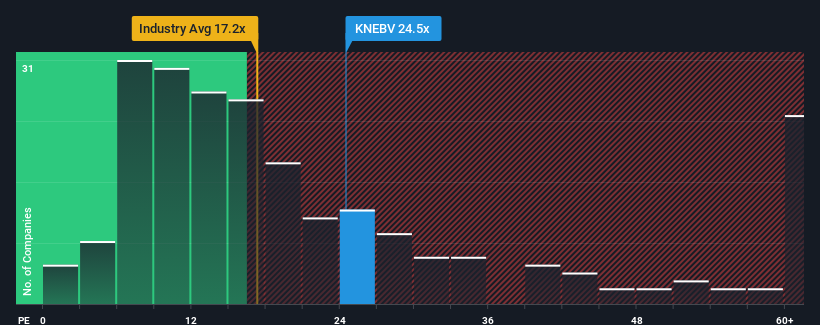Risks To Shareholder Returns Are Elevated At These Prices For KONE Oyj (HEL:KNEBV)

KONE Oyj's (HEL:KNEBV) price-to-earnings (or "P/E") ratio of 24.5x might make it look like a sell right now compared to the market in Finland, where around half of the companies have P/E ratios below 18x and even P/E's below 13x are quite common. However, the P/E might be high for a reason and it requires further investigation to determine if it's justified.
Recent times have been pleasing for KONE Oyj as its earnings have risen in spite of the market's earnings going into reverse. The P/E is probably high because investors think the company will continue to navigate the broader market headwinds better than most. If not, then existing shareholders might be a little nervous about the viability of the share price.
Check out our latest analysis for KONE Oyj

Does Growth Match The High P/E?
In order to justify its P/E ratio, KONE Oyj would need to produce impressive growth in excess of the market.
If we review the last year of earnings growth, the company posted a worthy increase of 6.3%. Still, lamentably EPS has fallen 4.1% in aggregate from three years ago, which is disappointing. Accordingly, shareholders would have felt downbeat about the medium-term rates of earnings growth.
Looking ahead now, EPS is anticipated to climb by 7.3% each year during the coming three years according to the analysts following the company. With the market predicted to deliver 15% growth per annum, the company is positioned for a weaker earnings result.
With this information, we find it concerning that KONE Oyj is trading at a P/E higher than the market. Apparently many investors in the company are way more bullish than analysts indicate and aren't willing to let go of their stock at any price. There's a good chance these shareholders are setting themselves up for future disappointment if the P/E falls to levels more in line with the growth outlook.
What We Can Learn From KONE Oyj's P/E?
Typically, we'd caution against reading too much into price-to-earnings ratios when settling on investment decisions, though it can reveal plenty about what other market participants think about the company.
Our examination of KONE Oyj's analyst forecasts revealed that its inferior earnings outlook isn't impacting its high P/E anywhere near as much as we would have predicted. When we see a weak earnings outlook with slower than market growth, we suspect the share price is at risk of declining, sending the high P/E lower. Unless these conditions improve markedly, it's very challenging to accept these prices as being reasonable.
Don't forget that there may be other risks. For instance, we've identified 1 warning sign for KONE Oyj that you should be aware of.
It's important to make sure you look for a great company, not just the first idea you come across. So take a peek at this free list of interesting companies with strong recent earnings growth (and a low P/E).
Valuation is complex, but we're here to simplify it.
Discover if KONE Oyj might be undervalued or overvalued with our detailed analysis, featuring fair value estimates, potential risks, dividends, insider trades, and its financial condition.
Access Free AnalysisHave feedback on this article? Concerned about the content? Get in touch with us directly. Alternatively, email editorial-team (at) simplywallst.com.
This article by Simply Wall St is general in nature. We provide commentary based on historical data and analyst forecasts only using an unbiased methodology and our articles are not intended to be financial advice. It does not constitute a recommendation to buy or sell any stock, and does not take account of your objectives, or your financial situation. We aim to bring you long-term focused analysis driven by fundamental data. Note that our analysis may not factor in the latest price-sensitive company announcements or qualitative material. Simply Wall St has no position in any stocks mentioned.
About HLSE:KNEBV
Proven track record with adequate balance sheet and pays a dividend.
Similar Companies
Market Insights
Community Narratives




